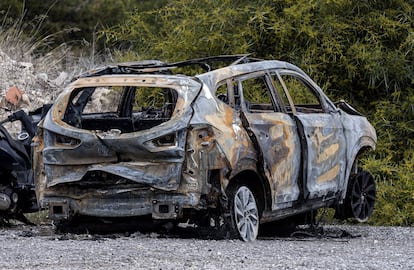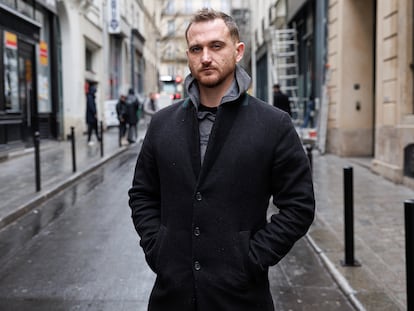A man found riddled with bullets in Spain, confirmed as Russian pilot who defected to Ukraine
Maxim Kuzminov escaped with his combat helicopter in August, in a daring move that was used as propaganda by Kyiv. Russia’s spy chief says the ‘traitor,’ who was shot and run over with his own car, was a ‘moral corpse’

The man found dead last week with six bullet holes in his body in Villajoyosa, a city in Spain’s Mediterranean coast, is Maxim Kuzminov, the Russian pilot who defected last August with his combat helicopter and surrendered to the Ukrainian Army, as confirmed by sources from Spain’s Civil Guard. The identity of the murdered man has been confirmed through his fingerprints, since he was carrying false documentation. The Ukrainian media Kyiv Post reported on Monday that the representative of Ukrainian military intelligence (GUR) Andriy Yusov had confirmed Kuzminov’s death in Spain. Kuzminov’s escape with a Mi-8 helicopter to a military base in the Kharkiv region was used for propaganda purposes by Kyiv authorities, who offered protection to him and his family. On Tuesday, Sergei Naryshkin, the head of Russia’s SVR foreign intelligence service, was quoted by Russian state news agencies as saying that “this traitor and criminal became a moral corpse at the very moment when he planned his dirty and terrible crime.”
The body was found on February 13 on the access ramp of the garage of a residential complex, from where the attackers fled in their victim’s car after also running him over with it, according to sources familiar with the investigation. The car was found shortly afterwards on fire in the neighboring town of El Campello. Civil Guard investigators noted from the outset that the deceased’s documentation, corresponding to a 33-year-old Ukrainian, could be false. On Monday, the Ukrainian press said that the victim was Kuzminov, and his identity has now been confirmed by Spanish law enforcement.

It was a local man who called the police at around 6:30 p.m. on February 13 after seeing a body with bullet injuries inside a residential estate whose residents are mostly Russian and Ukrainian citizens, according to sources familiar with the investigation. Residents told investigators that they did not know the victim well, but thought they had seen him “working at a nearby construction site.”
Little else is known about the Civil Guard investigation. Spanish government spokeswoman Pilar Alegría on Tuesday said that they would “let investigators do their work” and failed to disclose whether Kuzminov was under any kind of protection program.
Investigators suspect that the attackers were familiar with the victim’s daily routines, and may have been watching him for some time. The coordinated way they went about the killing first made the Civil Guard suspect that it might be a settling of scores between organized crime gangs.
The Russian’s desertion and escape became known in September of last year, when the Ukrainian GUR published images in which the pilot (who was 28 years old at the time) explained how he was contacted by enemy military intelligence, which offered him to transfer him to the Ukrainian side in exchange for money and protection. In the video you can see Kuzminov landing with his helicopter, a Mi-8 fighter, at a military base in the Kharkiv region, in eastern Ukraine and bordering Russia.
As reported at the time by the head of the Ukrainian GUR, Kyrylo Budanov, Kuzminov crossed the border flying below the radar detection area along with other members of the crew who did not know of the pilot’s plans and died when they tried to flee after landing. Budanov also explained then that Ukrainian military intelligence had managed to remove the defecting pilot’s family from Russia, as reported by the Efe news agency. The pilot then said that they guaranteed his safety, offered him new documents and compensation of half a million dollars before proceeding to plan the operation.
Maxim Kuzminov did not want to go to war and ended up flying his Mi-8 helicopter to Ukraine in a joint operation with that country’s intelligence services. The pilot had graduated from the Sizran Aviation School in southern Russia and was assigned to serve in the Russian Far East, where among his colleagues he had a reputation for being a “calm person” and for requesting “peaceful work,” cargo operations that had nothing to do with military missions, according to the Russian Telegram channel Baza.
Kuzminov himself explained that he had defected because he was against the Russian invasion of Ukraine. “I regret what is happening, the murders, the tears, the blood,” he said in a documentary released by the intelligence services, assuring that in Ukraine there were “neither fascists nor Nazis” as Moscow claimed. “I don’t want to be complicit in Russian crimes,” he said.
✊ BREAKING: Russian military Mi-8 helicopter pilot Maxim Kuzminov who defected to Ukraine in his helicopter will likely continue to fly helicopter missions, but for Ukrainian Armed Forces. His grandfather was a renowned Soviet fighter & test pilot. https://t.co/OqRMLEcdJj pic.twitter.com/KfouCD6R30
— Igor Sushko (@igorsushko) September 5, 2023
Kuzminov made the final decision while flying near the Russian-Ukrainian border on August 9. He then guided the helicopter across the border at an extremely low altitude. “Apparently, for three or four days no one (in Russia) understood what had happened to me. I landed and they welcomed me (in Ukraine),” he said. According to the video released by Kyiv, Kuzminov was injured after landing, but was offered medical assistance.
Meanwhile, in Russia, military authorities opened a case for “treason” against Kuzminov, and the relatives of his two companions who were murdered after landing in Ukraine asked that he pay with his life for what he did. The crewmates, killed while trying to flee, were decorated post-mortem by the Russian authorities.
Sign up for our weekly newsletter to get more English-language news coverage from EL PAÍS USA Edition
Tu suscripción se está usando en otro dispositivo
¿Quieres añadir otro usuario a tu suscripción?
Si continúas leyendo en este dispositivo, no se podrá leer en el otro.
FlechaTu suscripción se está usando en otro dispositivo y solo puedes acceder a EL PAÍS desde un dispositivo a la vez.
Si quieres compartir tu cuenta, cambia tu suscripción a la modalidad Premium, así podrás añadir otro usuario. Cada uno accederá con su propia cuenta de email, lo que os permitirá personalizar vuestra experiencia en EL PAÍS.
¿Tienes una suscripción de empresa? Accede aquí para contratar más cuentas.
En el caso de no saber quién está usando tu cuenta, te recomendamos cambiar tu contraseña aquí.
Si decides continuar compartiendo tu cuenta, este mensaje se mostrará en tu dispositivo y en el de la otra persona que está usando tu cuenta de forma indefinida, afectando a tu experiencia de lectura. Puedes consultar aquí los términos y condiciones de la suscripción digital.
More information
Archived In
Últimas noticias
Welcome to the post-religion era: The idea of Christianity as the absolute truth has become obsolete
‘I thought you would like it’: The risky sexual practice popularized by TV shows and TikTok
The digitalization of tourism: ‘They promise experiences and gave us the worst possible one’
Mexican peso defies uncertainty with forecasts of a new period of stability in 2026
Most viewed
- Sinaloa Cartel war is taking its toll on Los Chapitos
- Reinhard Genzel, Nobel laureate in physics: ‘One-minute videos will never give you the truth’
- Oona Chaplin: ‘I told James Cameron that I was living in a treehouse and starting a permaculture project with a friend’
- Why the price of coffee has skyrocketed: from Brazilian plantations to specialty coffee houses
- Silver prices are going crazy: This is what’s fueling the rally









































